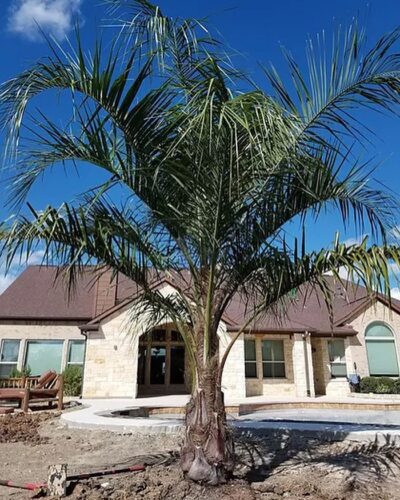Mule Palm looks like an animal with a similar name. Once established, it is quite hardy. It brings an island-like vibe to landscapes.
Native to Florida, the Mule palm (Butiagrus nabonnandii) is the hybrid of Pindo Palm (Butia capitata), pollinated by Queen Palm (Syagrus romanzoffiania). When large enough, it is extremely resilient to frost and can withstand temperatures as low as 14 F (-10C). As the common name states, this palm is sterile, and all palms can be produced by hand pollination.
The mule palm has a heavy gray trunk coated with old leaf bases, and deep green arched foliage develops from the trunk. Pinnate or feather-like leaves grow up to 5-10 feet long. It forms small pink blossoms on branched inflorescence.
Its rarity and moderate size make it a treasurable plant for warm climate gardens, the likeness of coconut to areas where the true coconut (Cocos nucifera) would not flourish.
Family: Arecaceae
Botanical Name: Butiagrus nabonnandii
Common Names: The Mule Palm, Butia Queen Cross, Pindo Palm, Butia x Syagrus
Mule Palm Hardiness Zones: USDA Zones 9a to 11
Propagation: Planted by seeds
Mule Palm Tree Information

Mule Palms are fast-growing and resilient and can mature up to 30 to 40 feet tall in full sun or diffused light. Shorter than the Queens Palm, mature Mules have graceful curved fronds that grow more than 6 feet long. The green fronds are delicate, and the sturdy, blue-gray leaflets are drooping.
This hybrid flowers more than once a year but rarely sets viable seeds. The flowers bloom in a soft pink shade that makes this Palm more beautiful. Since Mule palms are infertile, 95 percent of the seeds are aborted before maturity, so seedlings cannot be produced. However, the fruit is completely edible and very delicious.
Ideal Growing Conditions for Mule Palm
Light
This Palm needs around 80-100 percent sunlight. In the northern hemisphere of their grow zone, Hardy Mule Palms should be taken indoors and protected during the winter months. If it is in a planter, the potted plant will thrive in the summer months around colder zones but must be taken inside before winter.
Soil
This palm likes moist, well drained soil that is aerated. It flourishes most when root bound, so if it is in a planter, make sure to change it into a bigger size. If the palm is in the outdoor garden, then make sure all the other conditions are appropriate, as the soil will feed the right nutrients as it grows.
Water
The Mule Palm likes a moderate amount of water. Since it can be resilient in conditions of drought when mature, watering twice a week would be sufficient. Make sure the soil is not soggy but moist, and water the tree from the bottom up.
Fertilizer
Fertilize every alternate month or during spring and again during late summer with a slow-releasing palm granule fertilizer that contains nutrients not found in most sandy soils. When the frizzle top appears, that means the fronds are not getting enough nutrition. There is no way to revive any fronds with dead and deformed leaflets. Therefore, you must wait until healthy fronds grow and replace malnourished leaves.



